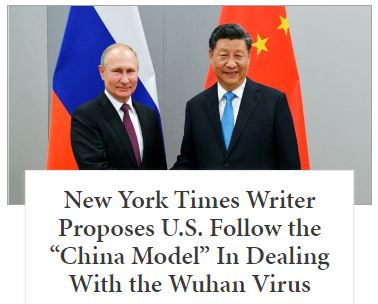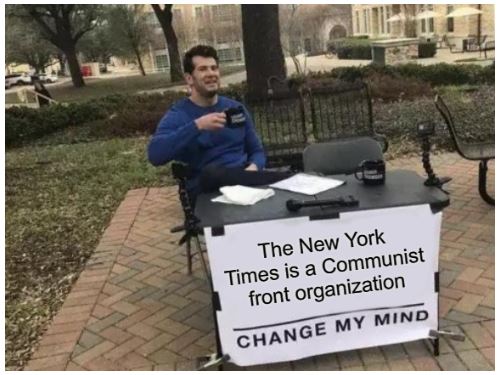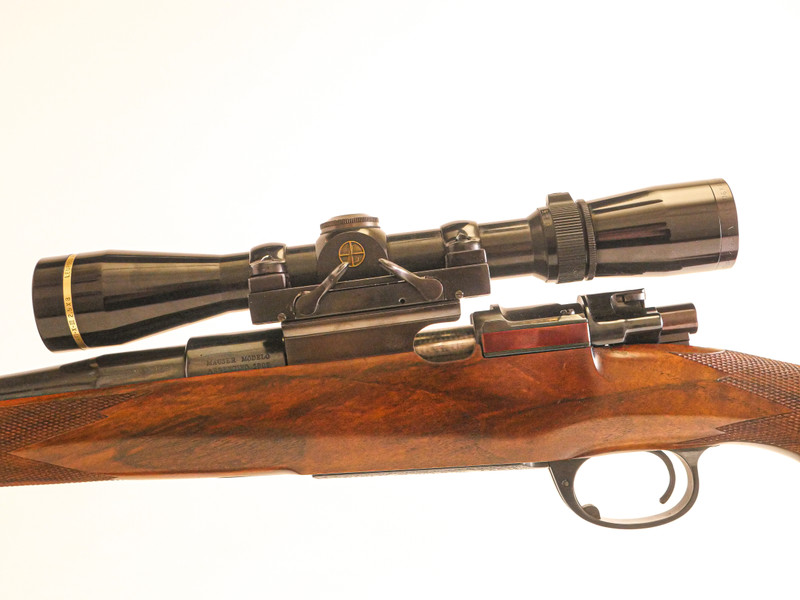

American Special Ops Forces Are Everywhere
They’ve become a major military player—and maybe a substitute for strategic thinking.








But if some kind Soul was to give me this. There is no way in hell that I would say “No Thanks” Grumpy


Addressing the abominable news from Boulder, Colo., on Monday, President Biden acknowledged that he was “still waiting for more information regarding the shooter.” And then, without pausing for breath, he said it: “I don’t need to wait another minute, let alone an hour,” Biden affirmed, “to take commonsense steps that will save the lives in the future and to urge my colleagues in the House and Senate to act.”
With respect, Mr. President, you do.
In front of the cameras, Biden called upon the Senate to pass “universal background checks.” But Colorado, in which these killings took place, already has such a system — and, besides, the shooter bought his gun from a store, not privately, passing a background check in the process. Responding to Biden’s demand, Senator Marco Rubio was justifiably confused. “I just don’t understand why everybody keeps focusing on that,” Rubio said. “It wouldn’t have prevented any of these shootings.”
The president’s other ideas were just as ill-considered. As he confirmed once again, Biden hopes to prohibit the sale of certain cosmetically displeasing rifles and to ban magazines that are capable of holding more than ten rounds. But, as one of the architects of the now-expired 1994 “assault-weapons ban,” he should know better than that. Not only are so-called “assault weapons” used so infrequently in crimes that the FBI does not even keep statistics — rifles of all types, recall, are used less frequently as murder weapons than are hammers, fists, or knives — but the evidence that prohibiting them does anything of consequence is non-existent.
When, in 2004, the “assault-weapons” ban was up for renewal, a report issued by the Department of Justice submitted that “should it be renewed, the ban’s effects on gun violence are likely to be small at best and perhaps too small for reliable measurement.” Congress let it lapse, and, since then, the evidence has become no stronger. In their 2014 work, The Gun Debate: What Everyone Needs to Know, Stanford University’s Philip J. Cook and Kristin A. Goss concluded that “there is no compelling evidence that [the ban] saved lives,” while, in a research review that was updated in April of 2020, the RAND Corporation found the evidence that “assault-weapons” bans reduce homicides in general and mass shootings in particular to be “inconclusive.” The AR-15 is the most commonly owned rifle in the United States, and, as such, is almost certainly protected under the Supreme Court’s “in common use” standard. In Congress and in the courts, “inconclusive” ain’t gonna cut it.
“This is not a partisan issue,” President Biden said on Monday, “it’s an American issue.” And, indeed, it is. And yet Biden’s rhetoric suggests that he believes this dispute is between a set of people that has all the right answers and a set that simply refuses to accept that they’re wrong — a conviction that could not be further from the truth. Only one in four Americans believes that “stricter gun control” would “help a lot” to prevent gun violence, while more than half believe that universal background checks would make either a “small difference” or “no difference at all.” Over time, gun-control advocates such as Biden have simply tuned out this fact, to the point at which they are now unable to conceive of their critics as anything other than corrupt, bloodthirsty wreckers. Even now, with the National Rifle Association as weak as it has been in decades, gun-controllers assume that Congress’s continued hesitance must be the result of something nefarious. It’s not. Americans just aren’t sold on the agenda.
And why would they be, given that that agenda is built atop the pretense that there is an easy answer to an appalling and vexatious problem — the Constitution be damned. Public polling shows that even the most popular gun-control ideas tend to become disfavored once the debate shifts from the abstract to the particulars, and it is the particulars that matter. There are no panaceas, only hard work. We must, of course, try to keep guns out of the hands of those who should not have them. We must, of course, do what we can to address mental illness. We must, of course, invest in policing. But we should not seek symbolic victories at the expense of the Bill of Rights, by banning the most popular rifle in America, overriding the background-check systems of 37 states, and pretending that the Second Amendment doesn’t exist.


They’ve become a major military player—and maybe a substitute for strategic thinking.

Illustrations by Mike McQuade
Image above, clockwise from top left: A U.S. Army Special Forces sniper, 1991; the aftermath of Operation Eagle Claw, the failed U.S. rescue operation in Iran, 1980; a marine during the invasion of Grenada, 1983; Captain Vernon Gillespie Jr. in Vietnam, 1964; soldiers on patrol at Camp Victory, in Somalia, 10 days after 18 Americans were killed during the Delta-led Battle of Mogadishu, 1993.*
This article was published online on March 12, 2021.
Updated at 7:17 p.m. ET on March 12, 2021.
Within the span of a few decades, the United States has utterly transformed its military, or at least the military that is actively fighting. This has taken place with little fanfare and little public scrutiny. But without any conscious plan, I have seen some of the evolution firsthand. One of my early books, Black Hawk Down, was about a disastrous U.S. Special Ops mission in Somalia. Another, Guests of the Ayatollah, about the Iran hostage crisis, detailed an abortive but pivotal Special Ops rescue mission. U.S. Special Operators were involved in the successful hunt for the drug lord Pablo Escobar, the subject of Killing Pablo, and they conducted the raid that ended the career of Osama bin Laden, the subject of The Finish. By seeking out dramatic military missions, I have chronicled the movement of Special Ops from the wings to center stage.
Big ships, strategic bombers, nuclear submarines, flaring missiles, mass armies—these still represent the conventional imagery of American power, and they absorb about 98 percent of the Pentagon’s budget. Special Ops forces, in contrast, are astonishingly small. And yet they are now responsible for much of the military’s on-the-ground engagement in real or potential trouble spots around the world. Special Ops is lodged today under the Special Operations Command, or SOCOM, a “combatant command” that reports directly to the secretary of defense. It has acquired its central role despite initially stiff resistance from the conventional military branches, and without most of us even noticing.
It happened out of necessity. We now live in an open-ended world of “competition short of conflict,” to use a phrase from military doctrine. “There’s the continuum of absolute peace, which has never existed on the planet, up to toe-to-toe full-scale warfare,” General Raymond A. “Tony” Thomas, a former head of SOCOM, told me last year. “Then there’s that difficult in-between space.”
SOCOM, whose genealogy can be traced to a small hostage-rescue team in 1979, has grown to fully inhabit the in-between space. Made up of elite soldiers pulled from each of the main military branches—Navy SEALs, the Army’s Delta Force and Green Berets, Air Force Combat Controllers, Marine Raiders—it is active in more than 80 countries and has swelled to a force of 75,000, including civilian contractors. It conducts raids like the one in Syria in 2019 that killed the Islamic State leader Abu Bakr al-Baghdadi, and carries out drone strikes like the one in Iraq in 2020 that killed Iranian Major General Qassem Soleimani. It works to locate hidden nuclear-missile sites in North Korea.
ow did special ops come to occupy such a central role in American military operations—and even foreign policy?
The history of its rise is telling. In a defense establishment where each branch already sells itself as one of a kind—“The few. The proud”—there has been long-standing institutional distaste for a separate elite force, one that siphons off experience and talent and that is first in line for difficult missions. President John F. Kennedy bucked this convention when he stood up the Green Berets. It was a bright idea that burned out in Vietnam, where an initial commitment of Green Beret advisers—who did more than advise—escalated into a full-blown war, with more than 500,000 American troops deployed at its peak. The Green Berets survived as an elite unit, but many ambitious Army officers considered a berth in Special Forces a career-killer.
Then came the Iran hostage crisis, in November 1979. Two days after Iranian students stormed the U.S. embassy in Tehran, America’s top brass convened in the “Tank,” a subterranean conference room at the Pentagon, to consider how the military might respond if President Jimmy Carter ordered it to act.
Something called the Delta Force already existed on paper. It was the brainchild of Colonel Charlie Beckwith, a profane, hard-drinking, stubbornly tenacious Army officer who had served briefly with the British Special Air Service in Malaya. He had agitated so long to create a similar multipurpose commando unit within the U.S. military that he had alienated many up the chain, which helped explain why he was still a colonel when he retired. But in the mid-1970s, two spectacular rescue missions captured the headlines. A special Israeli unit stormed an airport in Entebbe, Uganda, in 1976, rescuing more than 100 passengers who had been taken from a hijacked airliner.* A year later, a special German unit did much the same in Mogadishu, Somalia. Beckwith’s stock abruptly rose.
When the Tehran embassy was seized, Delta Force had yet to undertake a mission, and the challenge posed was beyond any imagined for it. Rescuing scores of American hostages from a city of hostile millions who gathered regularly to chant “Death to America,” situated hundreds of miles from any potential staging area, was nothing like storming a parked airliner. But Carter wanted a military option.
“Obviously, we don’t want to do this,” said Major Lewis “Bucky” Burruss, Beckwith’s operations officer, as he briefed the brass in the Tank. The “if we must” plan he outlined was a bold and daring Rube Goldberg scenario. The bottom line was plain: We’re not ready.
Months later, they had to be; Carter was desperate. A new plan had been drawn up, only marginally more plausible. Choppers would deliver the Delta team to Tehran and then would pluck the team and the rescued hostages from a stadium near the embassy. They would all be flown to an airfield secured by a company of Rangers. Eagle Claw, as the mission was called, never cleared the first hurdle—getting to Tehran. The only helicopters large enough for the job couldn’t be refueled in-flight, so the choppers had to perform a complex nighttime rendezvous in the Iranian desert with tanker aircraft. An accident at the landing site ignited a fireball that killed eight servicemen. The mission remains one of the most humiliating failures in American military annals—a failure that became the impetus for expanding Special Ops.
In the aftermath of Eagle Claw, an investigation known as the Holloway Commission found the Pentagon woefully unprepared for daring, joint, pinpoint missions. It revealed a crippling lack of interservice and intergovernmental cooperation. Mission planners had had to plead to obtain blueprints of the embassy compound in Tehran. The Navy pilots flying the helicopters across the desert had not even conducted the practice runs the planners had requested.
As a remedy, the Holloway Commission recommended the creation of a Joint Special Operations Command—JSOC, as it would be known. The service branches hated the idea. Admiral James Stavridis, a former U.S. supreme allied commander in Europe and a man who spent his entire career in the conventional ranks, told me, “The Navy didn’t want to give up the SEALs, and the Army didn’t want to give up the Ranger battalions, and the Marine Corps wouldn’t even talk about it. The services fought it and fought it and fought it, at every level.”
Once created, JSOC was treated like a poor stepchild. In the end, a staff of 70 was dispatched to Fort Bragg to handle administrative chores. The group was given Delta Force, a SEAL team, and a rotating Ranger battalion for specific missions. A Special Ops helicopter unit was created. But JSOC depended on haphazard funding and relied on a grudging chain of command for missions.
That is how things stood in October 1983, when the U.S. invaded Grenada, a tiny island in the Caribbean. Its Cuba-aligned Communist government had collapsed, and its leader, Maurice Bishop, had been murdered. Saying he feared for the safety of 600 American medical students at the island’s St. George’s University, President Ronald Reagan had ordered the military to seize control of Grenada and bring the students home. Rescuing hostages being its prime focus, JSOC was a key player in the invasion, which was over fast. It was celebrated as a rousing success by the Reagan White House. But within the military, it was seen as an embarrassment.
Thomas’s platoon was part of an assault on the Calivigny barracks, where several hundred Cuban and Grenadian forces had reportedly retreated for a last stand. The attackers were crammed into four Black Hawks, as many as 15 Rangers in each helicopter—“I mean, just ridiculous loads,” Thomas recalled.
“We came skimming in over the ocean and had three out of the four helicopters crash,” Thomas said. Three more people died. No Cubans or Grenadians were at the barracks.
Major General Richard Scholtes, who had been the JSOC commander at the time of the operation, testified about these and other failures in a closed session of a Senate Armed Services subcommittee in August 1986. Senator Sam Nunn called the testimony “profoundly disturbing, to say the least.” And then he did something about it.
The disaster in iran had led to JSOC. The mistakes in Grenada led to SOCOM. Thanks to an amendment sponsored by Nunn and Senator William Cohen, Special Ops got its own management and its own budget. Its annual budget today is about $13 billion, which is a sacrosanct 2 percent of all military outlays (and roughly what it costs to build an aircraft carrier). The Nunn-Cohen amendment also gave SOCOM clout. From now on, Special Ops would be headed by a four-star general or admiral, and its mission began to expand.
In 1987, Stavridis was a lieutenant commander on a cruiser stationed in the Persian Gulf as part of Operation Earnest Will, the largest naval-convoy mission since World War II. It was guarding Kuwaiti oil tankers, which were a lifeline for Saddam Hussein, who was then locked in a seven-year war with Iran—and being supported by the United States, his future enemy. The tankers were being preyed upon by Iranian forces. Special Ops teams used American ships as platforms to disrupt and counter Iranian attacks. Stavridis was impressed.
“It was the first time that we really started to see them in the field,” he recalled. The Kuwaiti ships had to be boarded and protected, which was not the kind of work the regular Navy did. “We, the Navy—Big Navy—hadn’t boarded a ship in a century,” Stavridis said. “These guys were trained to do that … as opposed to me trying to grab a bunch of boatswain’s mates and hand them a .45 and say, ‘Follow me!’ ”
“Can you do that?” Powell asked Downing. Could he take out the Scuds?
Within days, JSOC teams were camped in remote desert observation posts, launching attacks on Iraqi missile columns from the air or swooping in across the sand in six-wheeled combat vehicles, looking like the pirate gangs of Mad Max. Questions would be raised later about whether these attacks were taking out real missile launchers or decoys fielded by Saddam, but there’s no doubt that the results achieved were fast and dramatic, and kept Israel off the battlefield.
Experienced socom soldiers were early adopters of new technology, often buying equipment off the shelf that was not available through normal supply lines. As in most other fields, modern telecoms would transform war-fighting.
In December 1998, Thomas had what he called a “sensor-to-shooter epiphany” in the closed back of a truck near Vrsani, a village in northeastern Bosnia. Then a lieutenant colonel, he was in command of a JSOC Delta squadron. The mission was manhunting. Thomas and the squadron had been tracking Radislav Krstić, a one-legged Serbian commander in the Yugoslav wars who had been indicted a month prior by the International Criminal Tribunal for the Former Yugoslavia, in The Hague.

Gunplay was a possibility, so Thomas had a list of strict no-go scenarios, among them the presence of local police, Russian troops, or children. As Krstić’s vehicle neared, first a Russian convoy approached, then a local military-police vehicle. Both passed by. Finally a school bus rolled into the picture. The effort seemed snakebit. At last, on the screen, Thomas watched the school bus clear the zone, with only seconds to spare. “Execute!” he ordered. Krstić’s vehicle was caught in the net, and he was taken without incident.
Thomas would be teased about the episode: an entire Delta squad to capture a one-legged Serbian? What stuck with him was how much more useful the screen had been than his own two eyes. Without the overhead view covering the whole stretch of road, he would have aborted the mission. It occurred to him: This is where we are going in the future.
Live video feeds were just the beginning. When Stanley McChrystal took over JSOC, in 2003, the U.S. invasion of Iraq was eight months old. Special Ops teams were still hunting Saddam and other “high-value targets” when a new enemy arose: Abu Musab al-Zarqawi, a jihadist known as “The Sheikh of the Slaughterers.” His followers were setting off bombs in crowded places, attacking American soldiers, and kidnapping “infidels” and beheading them in horrific videos posted online.
McChrystal was known as a relentless striver. Gaunt, hollow-eyed, and intense, he was famous for his ascetic discipline. He turned his task force into the most efficient hunter-killer force in the world, and a model for the entire command. McChrystal is not Sun Tzu. But in sizing up his adversary and responding creatively, he remade JSOC, and ultimately SOCOM itself. He recognized that the ability to digitize information—audio files, video files, maps, texts, emails, phone calls, documents—could steer him rapidly to targets.
Like most innovations, McChrystal’s was resisted, including by SOCOM itself. He wanted to expand and alter his mission, adding an array of expertise—in some cases, requiring civilian contractors—that had nothing to do with traditional soldiering. He explained the situation to me in a way that both made his position understandable and underlined the institutional imperatives that push in one direction only. “Inside my command, there were a bunch of people saying, ‘We need to pull back to the States and wait until there’s a hostage rescue or something like that, and we’ll do our specialized mission,’ ” McChrystal said. “And I told them, ‘Hey, if we’re not here doing a significant part of this, we’re not going to be able to claim our elite status and be first in line for resources and priority.’ ” There was also resistance from agencies whose support he needed, notably the CIA, which balked at moving interrogators, analysts, software engineers, and imagery experts out from under their direct control. But McChrystal got what he wanted.
Hostage rescue, manhunting, search-and-destroy missions—these had become the U.S. military’s active pursuits worldwide. Other events secured SOCOM’s status. The most dramatic was the killing of Osama bin Laden, in Abbottabad, Pakistan, in 2011. After the CIA traced his location, a SEAL team penetrated Pakistan’s air defenses and hit his compound. Thomas was second in command on that mission, under JSOC’s Admiral William McRaven, who became SOCOM commander later that year. Despite his background leading shooters, McRaven promoted the softer side of the command, long a major part of its portfolio—the Green Beret teams of people who were familiar with local languages and cultures, knew how to build ties with communities, and had the diplomatic skills to serve as advisers rather than call all the shots.
That approach found a receptive audience in President Barack Obama, who was trying to crush emerging terror threats while at the same time lower American troop levels overseas. SOCOM’s small units would steer the battle against Islamist networks in Africa and Asia, working primarily through local armed forces. Its intelligence network and aerial assets would give Kurdish, Iraqi, and Syrian fighters an overwhelming advantage against ISIS. Utilizing SOCOM, the U.S. was still in the fight, just not openly in the lead, and no longer carrying the full load. This opened Obama to political attacks for “leading from behind,” which revealed a fundamental misunderstanding of the change under way. Happy to keep American forces below the radar, Obama was eager to act when the occasion was ripe. Thomas described Obama as “a junkyard dog” when it came to national security.
There is a risk in being admired by those in charge. During Thomas’s tenure as SOCOM commander, from 2016 to 2019, the scope of his responsibility grew at a pace he calls “frantic.” New tasks were given to his already swollen organization, grafted on like afterthoughts, even as Obama’s successor as president made several dramatic troop reductions or withdrawals, notably in Syria and Afghanistan. Donald Trump’s words and policies were unpredictable, but SOCOM’s mission continued to enlarge.
McChrystal saw it coming. He remembers attending a military conference in 2007. He ran into another predawn gym rat, a retired Navy SEAL, who lamented, “It’s just not like the old days, is it?”
“No,” McChrystal agreed. Then he asked, “What do you mean?”
“These guys just aren’t—” McChrystal thought he was about to say “heroes” but had stopped himself. “They’re not like we were.”
“What are you talking about?” McChrystal replied. “These guys are doing a hundred times more than we ever dreamed of doing, and doing it better.”
His friend seemed disappointed by the response, so McChrystal explained further: “It’s not just a few, you know, burly men anymore. Shit, this is a machine now. You and I don’t even know how to run it.”
* Lead image credit: Illustration by Mike McQuade; images from Leif Skoogfors; Rolls Press / Popperfoto; Corbis; Larry Burrows / Life Picture Collection; Joel Robine / AFP / Getty
* This article originally stated that a special Israeli unit stormed a hijacked airliner on the tarmac in Entebbe, Uganda, in 1976, to rescue hostages. In fact, the hostages were rescued from an airport in Entebbe.
This article appears in the April 2021 print edition with the headline “How Special Ops Became the Solution to Everything.”
